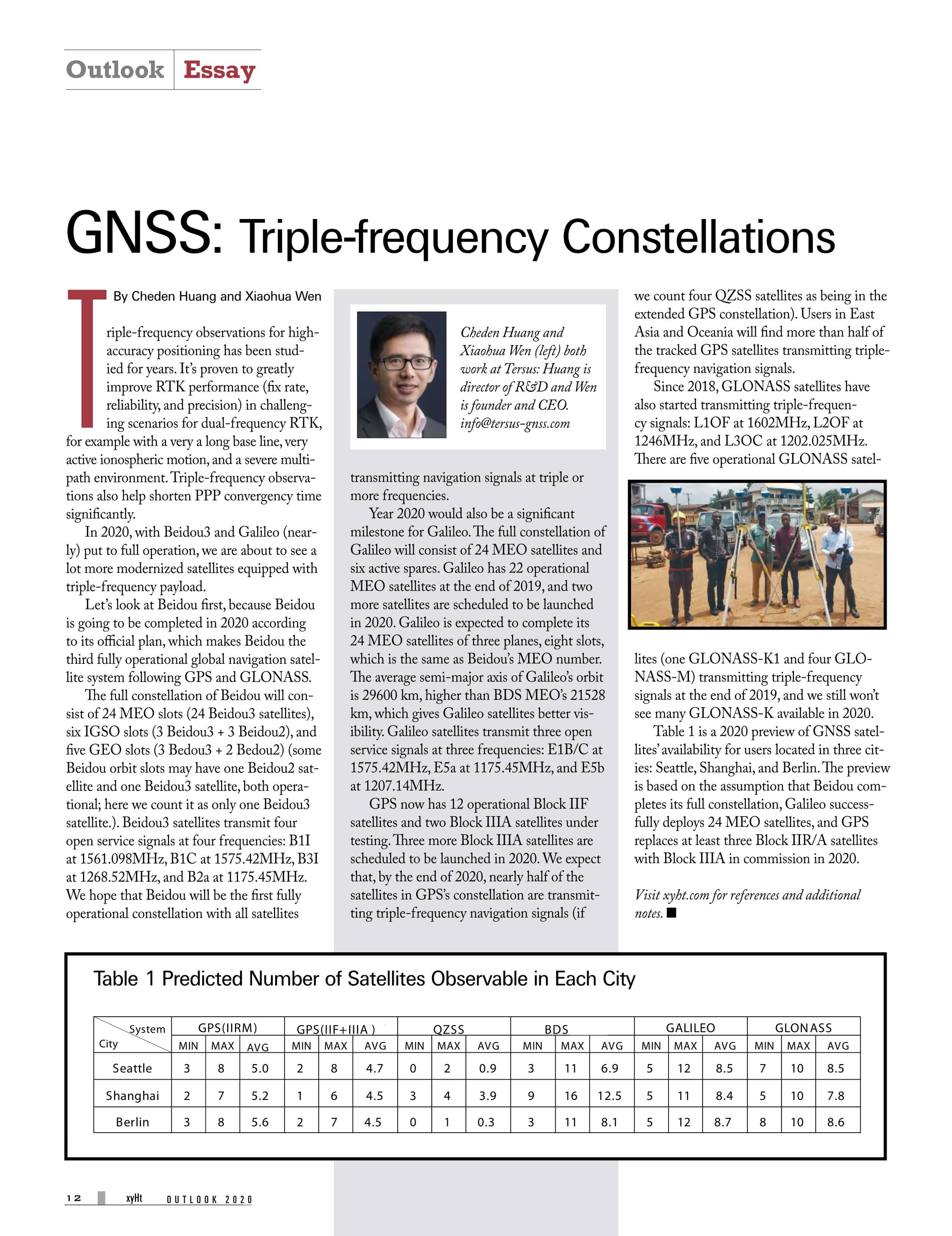
GNSS Trends of 2020 - 4 Constellation with Triple Frequencies in the Sky
Triple-frequency observations for high accuracy positioning has been studied for long time. It's proven to improve RTK performance (fix rate, reliability, precision) greatly in some challenging scenarios for dual-frequency RTK, say very lone base line, very active ionospheric motion, and severe multi-path environment. Triple-frequency observations also help shorten PPP convergency time significantly. In 2020, with Beidou3 and Galileo (near) put to full operation, we are about to see a lot more modernized satellites equipped with triple frequency payload.
We will take a look at Beidou first, because Beidou is going to be completed in 2020 according to its official plan, which makes Beidou the third full operational global navigation satellite system following GPS and GLONASS. The full constellation of Beidou will consist of 24 MEO slots (24 Beidou3 satellites), 6 IGSO slots (3 Beidou3 + 3 Beidou2), 5 GEO slots (3 Bedou3 + 2 Bedou2) (note1). Beidou3 satellites transmit 4 open service signals at 4 frequencies, B1I at 1561.098MHz, B1C at 1575.42MHz, B3I at 1268.52MHz, B2a at 1175.45MHz. Beidou is hopefully to be the first full operational constellation with all satellites transmitting navigation signals at triple or more frequencies (note2).
Year 2020 would also be a significant milestone for Galileo. The full constellation of Galileo will consist of 24 MEO satellites and 6 active spares. Galileo has 22 operational MEO satellites to the end of 2019, and 2 more satellites is scheduled to be launched in 2020. Galileo is expected to complete its 24 MEO satellites of 3 planes * 8 slots, which is the same as Beidou’s MEO number. The average semi-major axis of Galileo orbit is 29600 km, higher than BDS MEO’s 21528 km, that gives Galileo satellites better visibility. Galileo satellites transmit 3 open service signals at 3 frequencies, E1B/C at 1575.42MHz, E5a at 1175.45MHz, E5b at 1207.14MHz (note3).
GPS now has 12 Block IIF satellites operational, and 2 Block IIIA satellites under testing (note4). 3 more Block IIIA satellites are scheduled to be launched in 2020. We expect that by the end of 2020, near half satellites of GPS’s constellation are transmitting triple frequencies navigation signals. If we count 4 QZSS satellites as extended GPS constellation, for the east Asia and Oceania users, they would find more than half tracked GPS satellites transmitting triple frequencies navigation signals (note5).
From 2018, GLONASS satellites also start transmitting triple frequencies signals, L1OF at 1602MHz, L2OF at 1246MHz, L3OC at 1202.025MHz. There are 5 operational GLONASS satellites (1 GLONASS-K1 and 4 GLONASS-M) transmitting triple frequencies signals at the end of 2019, we still won’t see many GLONASS-K available in 2020(note6).
Following is a 2020 preview of GNSS satellites availability for users located at 3 cities, Seattle, Shanghai and Berlin. The preview is based on the assumption that Beidou completes its full constellation, Galileo successfully deploy 24 MEO satellites, and GPS replaces at least 3 Block IIR/A satellites with Block IIIA in commission in 2020.
(1) A satellite is considered to be observed when its elevation is greater than 5 degree.
(2) The average satellite number is calculated for 24 hours and the step is an hour.
(3) https://www.navcen.uscg.gov/?Do=constellationStatus shows prn12, prn14 and prn18 will be replaced by a new sat.
(4) All Beidou’s GEO and IGSO satellites are located above from 76°E to 140°E, these satellites make Shanghai see much more Beidou’s satellites than Seattle and Berlin.
(5) The highest elevation of QZSS satellites is about 15 degrees in Seattle and is about 10 degree in Berlin.
(note1) Some Beidou orbit slot may have one Beidou2 satellite and one Beidou3 satellite both operational, here we only count it as one Beidou3 satellite.
(note2) Beidou2 satellites transmit 3 open service signals at 3 frequencies, B1I at 1561.098MHz, B2I at 1207.14MHz, B3I at 1268.52MHz.
(note3) According to “Galileo E6-B/C Codes Technical Note”, Galileo E6-B (at 1278.75MHz) would be open service signal, but it has a 1000Hz symbol rate modulated on, which makes it not ideal for ranging purpose. Galileo E6-C (also at 1278.75MHz, the pilot component), may be encrypted in the future.
(note4) Only Block IIF and Block IIIA/F satellites of GPS are capable of transmitting triple frequencies navigation signal at L1 L2 L5.
(note5) QZSS satellites has almost the same scheme with GPS Block III satellites for civil signals, and QZSS system time is aimed to keep good alignment with GPS system time. It’s practical to treat QZSS satellites as extended GPS satellites for Baseband processing and positioning solution.
(note6) Ref https://en.wikipedia.org/wiki/List_of_GLONASS_satellites, 1 GLONASS-K1 702, 4 GLONASS-M 755 756 757 758
About Tersus GNSS Inc.
Tersus GNSS is a leading Global Navigation Satellite System (GNSS) solution provider. Our offerings and services aim to make centimeter-precision positioning affordable for large-scale deployment.
Founded in 2014, we have been pioneers in design and development GNSS RTK products to better cater to the industry’s needs. Our portfolios cover GNSS RTK & PPK OEM boards, David GNSS Receiver, Oscar GNSS Receiver, MatrixRTK [GNSS CORS Systems] and inertial navigation systems.
Designed for ease of use, our solutions support multi-GNSS and provide flexible interfaces for a variety of applications, such as UAVs, surveying, mapping, precision agriculture, lane-level navigation, construction engineering, and deformation monitoring.
Sales inquiry: sales@tersus-gnss.com
Technical support: support@tersus-gnss.com
